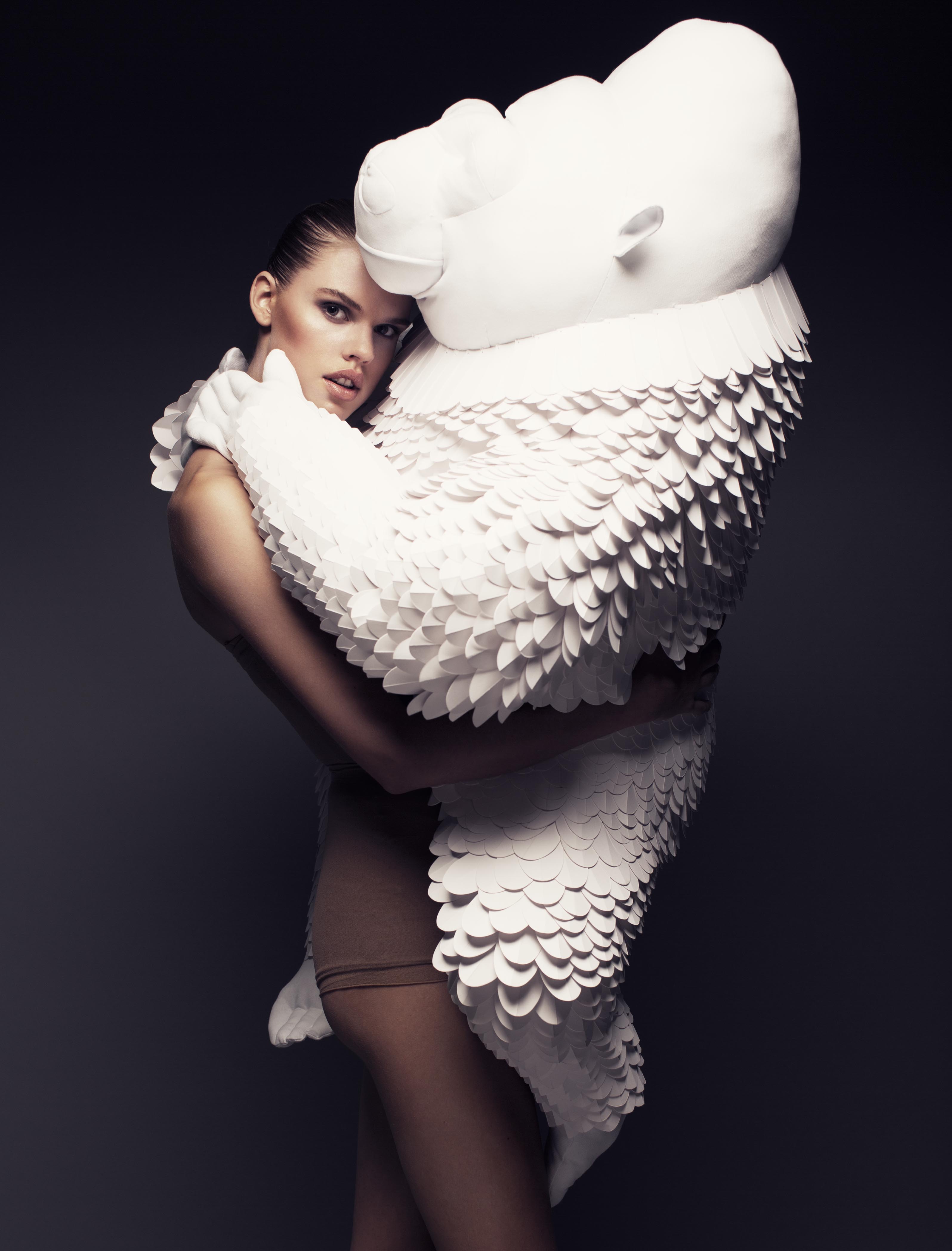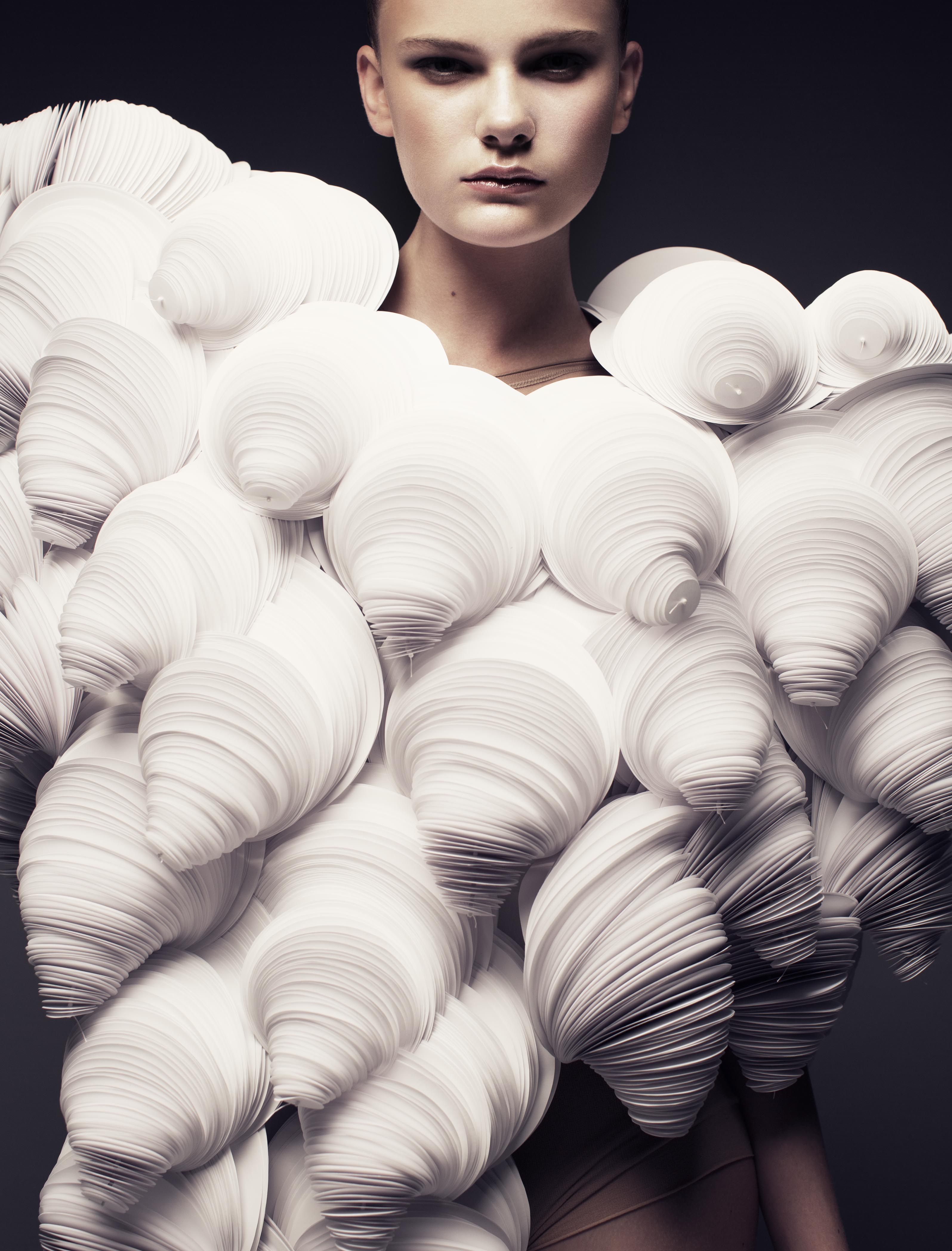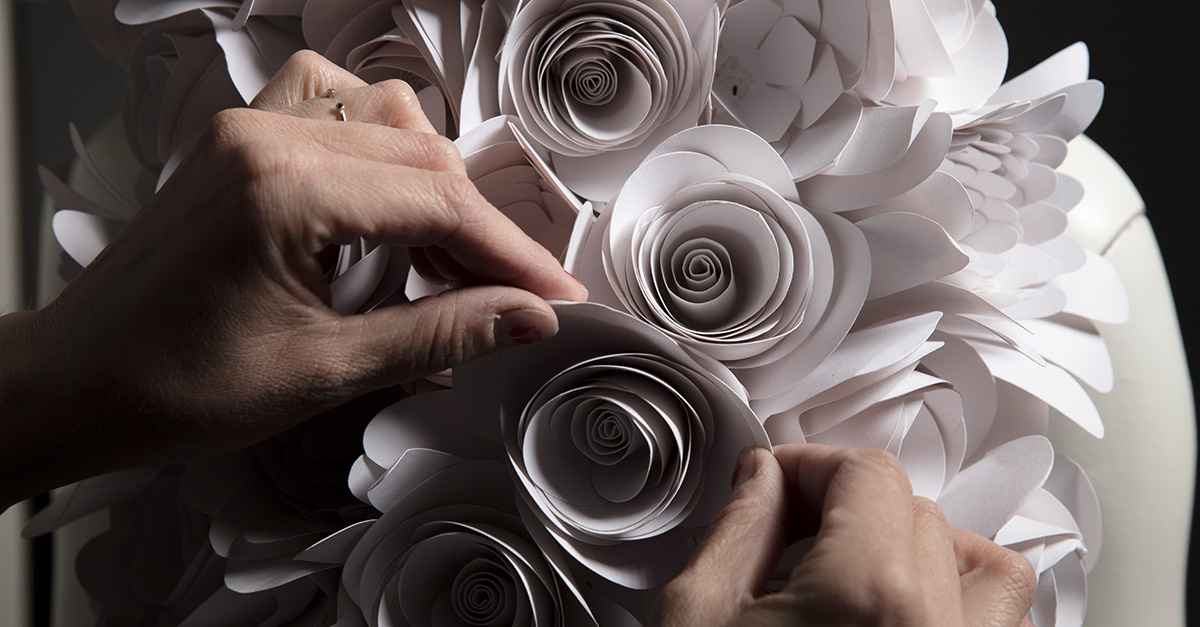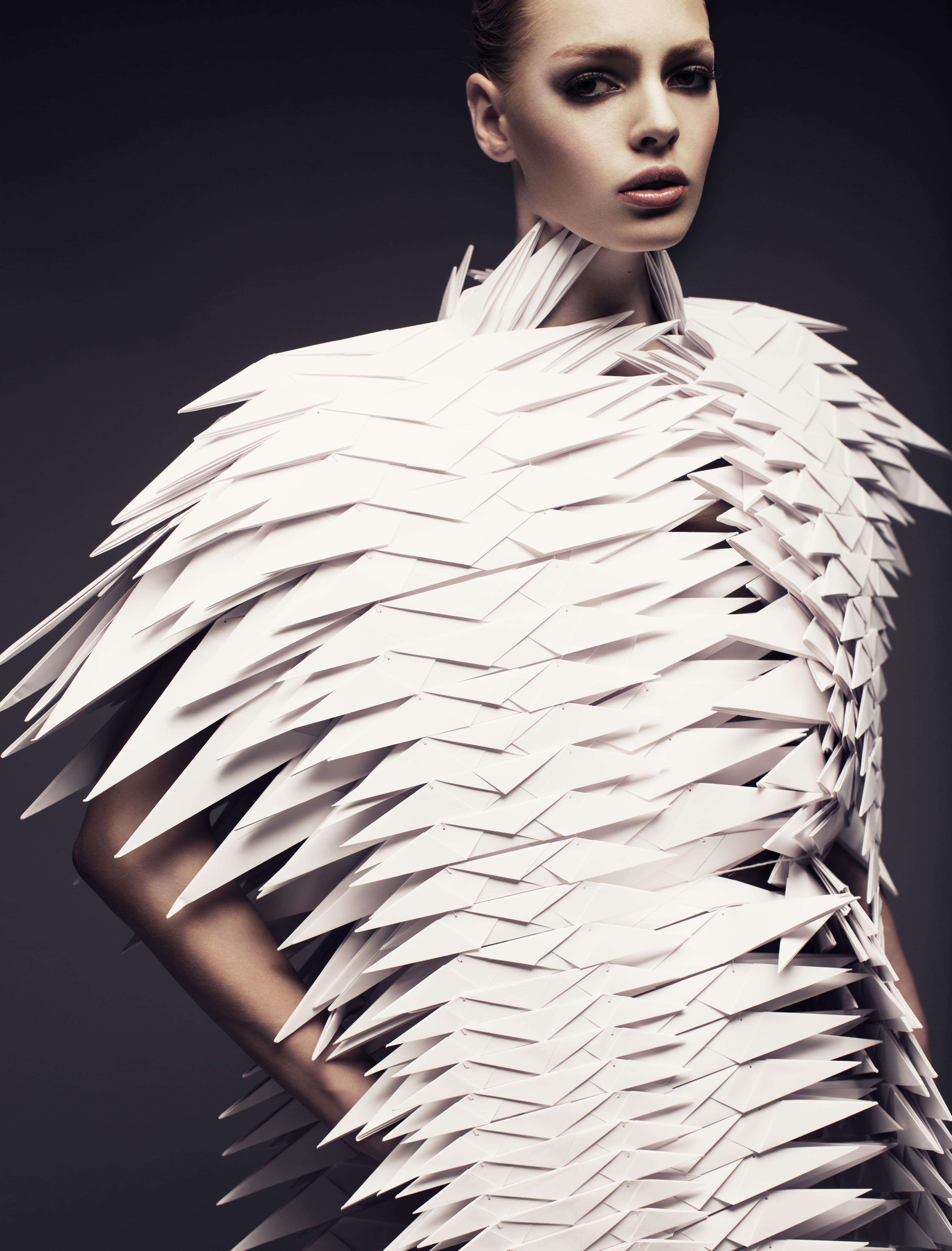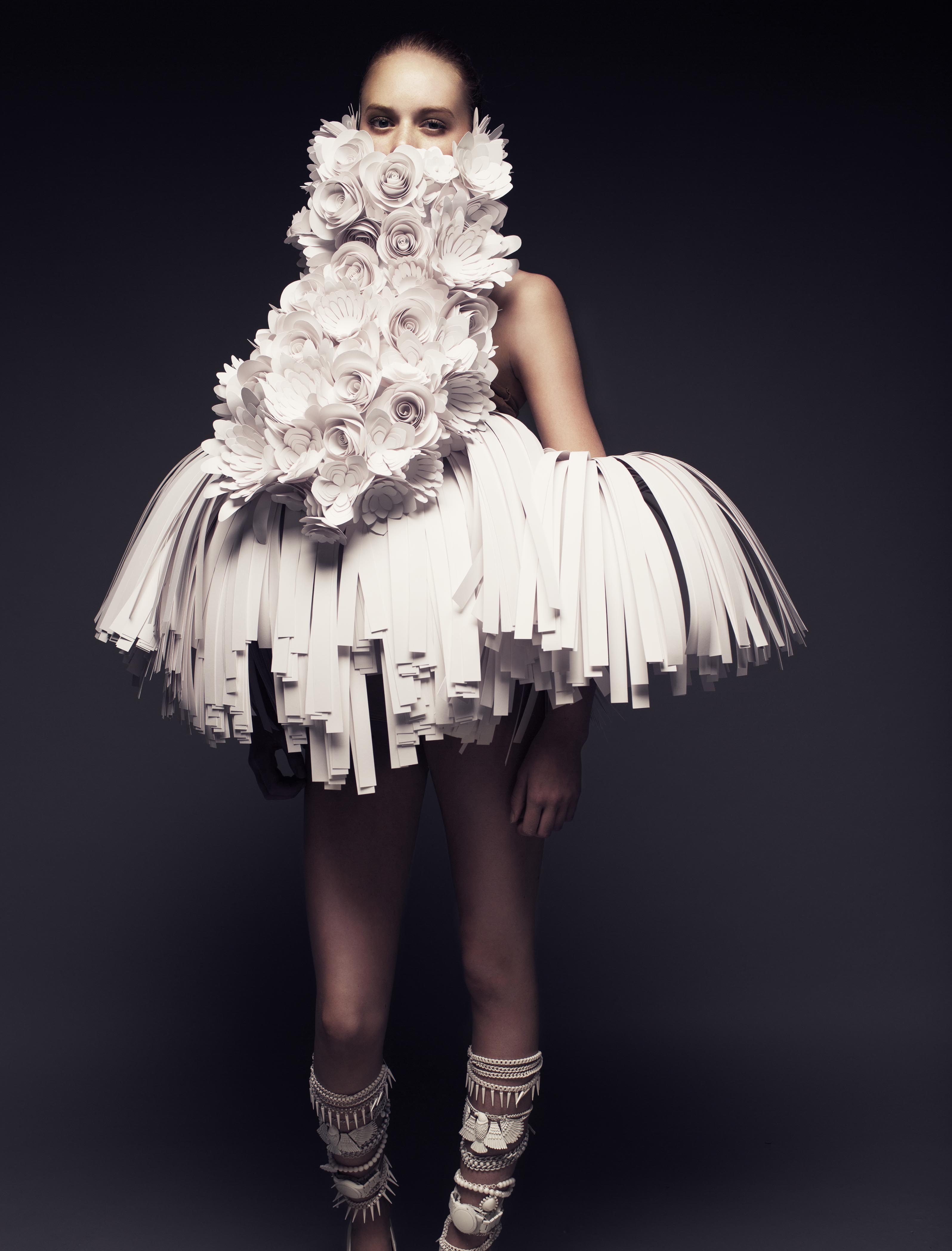
The future is handmade
Art and culture are excellent ways to turn given concepts upside down, and create new approaches and solutions. One avant-gardist, who does not fear new paths, is artist and designer Bea Szenfeld. She is the trained potter who’s giant paper dresses now can be found on celebrities, at the Nobel prize ceremony, in fashion magazines and in museums. We met with her to hear her thoughts on exploring new materials – and how she came to fell in love with paper.
Art, paper, scissors
Bea Szenfeld, has always felt an urge to express herself through different types of mediums and materials. She is a trained potter, cutter and fashion designer and has done her trainee at Stella McCartney’s. But she felt out of place working with fashion, and experienced that she came too far away from what she actually loved.
– After my training and education in fashion and design, I started my own brand of clothes, says Bea Szenfeld. But I noticed after some time that the majority of my time was spent on dealing and trading with textiles, or with marketing – and that was not my forte. I love design, and I love the human body. So I started doing some small projects on the side, where I had a more artistic approach to the human form and figure. That is when I began to do clothes in other material than fabric. And I noticed that when I did a dress out of salad or pasta, the focus shifted from “can I get this in another size?” to “oh, this is design – a new way of dressing the body and contouring silhouettes!”.
During this period, Szenfeld describes, she did many trials and errors with different materials, but quite soon discovered the simplicity with paper.
– I did some tests in paper, and thought “this is too good to be true!”, Bea Szenfeld laughs. It was incredibly simple, and paper is such a beautiful material. It's such an easy job, once you play in its league. Once you have learned paper, it is truly so gratifying!
Heavy light-weight
Even though Szenfeld has found her core material, it is still an explorational journey for her creations. Most often, it is the practical conditions that limits the creative possibilities in her work. Despite the light weight material, Szenfeld’s creation are surprisingly heavy, and sometimes hard to transport. Therefore, the garment is shipped in disassembled pieces – and then reassembled on a model when in use.
– The garments I make can often break in shipping or handling, and many of my pieces weigh over 20 kg, Szenfeld explains. So I have found a way to store and transport these creations in small pieces, where I instead dress on every single garment. I build these sculptures and assemble them one by one. Paper can withstand quite a lot, but not too much. Therefore, you need to trick the eye, and also the paper, a little. If I cut a little cardboard and a little tissue paper in between, I can trick the eye into thinking "this feels fragile", but still it is a support in the form of the solid cardboard.
Szenfeld has, with her experimental creations and unusual concepts, proven that sometimes you don’t need to label what you do. You just need to do. Her pieces really leaves no one unimpressed, and that is the intention. A common denominator in her work is emotions – and humor.
– Yes, humor is very important! Szenfeld laughs. I really try to be serious, but despite that, when I had my fashion show in 2015, people laughed when my models came out. Because "here comes the model carrying a 200-kilo gorilla like a handbag". I believe that fashion needs to be paused a bit, because it gets ridiculous when it gets too cool.
 "I believe my strength has been that I have never been still. I am constantly testing my way forward." Bea Szenfeld, artist & designer
"I believe my strength has been that I have never been still. I am constantly testing my way forward." Bea Szenfeld, artist & designer
Sustainable fashion
As recent times have shown, we need to rethink and challenge given frameworks to find a more durable way forward. Even though the art pieces requires a lot of material, the resources used are environmentally friendly, and most definitely circular.
– I work with plain paper, no special treatments on it or anything, Szenfeld explains. Plain paper, directly from the paper mill here in Sweden. The great thing about paper is that we have been producing and recycling paper for so, so many years. It is one of the oldest materials we reuse, which means that it is not rocket science - we know this, we know how to manage this resource.
All surplus and waste pieces from the art objects can be put straight in the paper recycling. Since no materials are mixed, everything can be pulled apart and recycled or reused. When the lifespan of a garment is finished, the threads are removed and the glass/plastic beads are reused. The paper is just put in the recycling bin. It really is circular art. And for the garments that still lives on, depending on the storage and treatment it can really be long lasting.
– My paper sculptures can be stored and kept for as long as you like, it all depends on how you handle them, Szenfeld explains. They cannot be exhibited in direct sunlight or in a humid room, but if they are handled by me or museum staff, they last for decades.
Different target groups
Apart from exhibiting her art at museums and in fashion magazines, Szenfeld is also a recurrent feature in one of Swedish Televisions most watched TV-magazines, Go’kväll (Good Evening). There she has a standing mission on a reoccurring basis, a DIY-project that is either recycled or upcycled.
– I love those projects, Szenfeld smiles. I have about 7 minutes to show a DIY-craft that people can do themselves at home. In those projects, I find that lamps and luminaires are among the best things to use. You can do simple things and it is always needed at home. And especially now with LED lighting, when the light source does not get hot, the possibilities are so much more and vivid! It really enables you to work with more recycled materials than previously.
Yet another aspect regarding the material is that people from so many different target groups can relate to it. Everyone from pre-schoolers, craftsmen, designers or engineers – they all enjoy the magic and illusions created with regular paper.
– That is truly one of the things I love about my paper clothes, that I can float out without a straight horizon, Bea Szenfeld says. If you like art, you may like my stuff. If you like fashion, you can like my stuff. When I exhibit in cities with paper or forest industry, there are usually visitors who work with paper - who have never seen it used like this. They might work with cardboard and large sheets, and so all of a sudden they see how their material can become something completely different. And those who love crafts, the same thing. You can do so much with paper, scissors, a ruler and some time - it's completely crazy! It's really lovely to find entrances to so many different audiences.
Tabula rasa
So, how does the future looks like for art in general, and more sustainable art in particular? Is there a visible trend for designers and artists to work more circular?
– Yes absolutely! Szenfeld states. I am part of the jury in Ung Svensk Form (Young Swedish Form) and at least half of all projects that contribute are about recycling and reusing. Either they reuse materials or create designs that are easy to reuse.
Not only is sustainability a high awareness among the upcoming artists and designers, so is also the love for crafts and handmade work.
– I love that, but we craftsmen must never relax and think that “this is good, now crafts are in", Szenfeld says with emphasis. We must always fight for recognition, and the time we spend. What we do is not a quick fix, a craft takes time to learn. That's something we need to explain to the new generation, that you have to take time with things. Now we have a world that spins so incredibly fast. From one day as unknown, to another day as world-famous on TikTok. That was not the case before, then you had the chance to grow up a little cautiously. Crafts are really slow techniques, and that is the way it must be.
Fact on Bea Szenfeld:
- She is trained potter and cutter, as well as graduated from Beckmans School of Design.
- After participating in Project Runway, she earned her internship at Stella McCartney.
- Has dressed celebrities such as Lady Gaga, Björk and Loreen.
- Designed the Swedish minister of Culture Alice Bah-Kunkhe’s dress for the Noble Dinner.
- Has explored other materials as well, and made a dress out of pasta for Barilla and clothes entirely of PVC.
TEKST MARIA VÅRENIUS
FOTO EA CZYZ, JOEL RHODIN
Relaterte nyheter

Når materialvalget er viktig, gir Wrapped et nytt syn på bærekraftig belysning
I en verden der hvert gram av materiale og hvert gram av CO2 teller, er Wrapped ikke bare en armatur, men et bevisst valg. Dette er Fagerhults mest bærekraftige armatur for pendlet montering noensinne, og det er ingen tilfeldighet.Hver minste detalj, hver eneste beslutning og hvert eneste materiale ble valgt med omhu. Bærekraft starter ofte med et enkelt spørsmål: Hva er produktet laget av? For Wrapped er svaret en kombinasjon av tre materialer som alle har sin egen miljøhistorie. Solid Board – en velkjent venn I Fagerhult møtte vi Solid Board for første gang i 2021 med Multilume Re:Think. Men for Wrapped har vi tatt det ett skritt lenger. Materialet består av en trelagskonstruksjon med 100 % resirkulert kjerne, et fornybart FSC-sertifisert topplag og en tynn beskyttende plastfilm. Det gir et materiale som er 65 % resirkulert – og en reduksjon i CO₂-utslipp på 89 % sammenlignet med ny ekstrudert aluminium. Bildegalleri: Solid Board Wrapped er laget av organisk Solid Board, resirkulert aluminium og resirkulert plast. Plast på en ny måte Plast er ofte et populært tema i samtaler om bærekraft. Men ikke all plast er lik. Wrapped bruker resirkulert plast som har levd et liv før, kanskje som en sjampoflaske eller matboks. Ny plast er annerledes, siden den aldri har vært innom butikkhyllen. Sitat: Josefin Carlsson Aluminium med en fortid På innsiden av Wrapped er to strukturelle komponenter laget av 100 % resirkulert aluminium. Dette materialet er også en del av en sirkulær infrastruktur, og det kan til og med ha vært en del av en Notor-armatur en gang i tiden. Sammenlignet med ny aluminium reduserer dette valget utslippene med 83 %. Designet med mindre – utviklet for å vare Men bærekraft handler ikke bare om hva man bruker, det handler også om hvor mye man bruker av det. Med sine 900 mm er Wrapped kortere enn en tradisjonell armatur på 1200 mm for pendlet montering. Bare denne reduksjonen i størrelse reduserer klimapåvirkningen med 25 %, uten at det går på bekostning av armaturens effekt. Josefin Carlsson sammenligner produkters klimapåvirkning i Fagerhults Experience Centre i Habo. For å forstå effekten av Wrapped er det lurt å se på hvor vi startet. I 2021 hadde Notor 65 – som ble laget av ny aluminium – en klimapåvirkning på 34 kg CO₂e. I 2024, med 75 % resirkulert aluminium, var dette tallet redusert til 25 kg CO₂e. I dag ligger Wrapped på rundt 12 kg CO₂e. «Det er en tredjedel av den opprinnelige Notor 65 og halvparten av dagens versjon – en stille revolusjon målt i kilo CO₂e», sier Josefin Carlsson. Etter sin lange levetid – som er anslått til å være 100 000 timer – er Wrapped klar for en like bærekraftig avslutning. Designen gjør den enkel å demontere, og hvert enkelt materiale kan resirkuleres og klargjøres for neste kapittel i den sirkulære økonomien.
Lukke ringen – og forlenge armaturens livssyklus
Konseptet med å gjenoppbygge gamle armaturer for å spare materiale og energi, blir stadig mer populært. Av og til trengs det bare litt kjærlighet og teknisk kunnskap for å få en utdatert armatur til å skinne igjen. Vi møtte Emma Hallman, Mathilda Holl og Andreas Ekslätt, teamet bak ReLight hos Fagerhult, for å snakke om utfordringene med å finne løsninger som tar gamle armaturer inn i fremtiden. Hos Fagerhult preges alt arbeid av en dypt forankret innovasjonskultur. Det kan hende det skyldes grunnleggeren Bertil Svenssons fokus på å løse utfordringer med til tider begrensede midler – og nysgjerrighet og engasjement. I motsetning til i dag er det ikke sikkert at bærekraft var et kjent begrep på den tiden. Men å bruke ressursene våre på en bevisst måte og ha som mål å levere høy kvalitet har alltid kjennetegnet Fagerhult. I dag har et nytt fokus på sirkularitet fått oss til å tenke nytt og gjort oss bevisste på å finne løsninger som varer lenge. Fagerhults Bespoke Lighting Solutions-avdeling (BLS) har utviklet unike armaturer og tilpassede løsninger i mange år. Derfor er vi godt kjent med å renovere og oppdatere gamle armaturer. Men målet om å gjenbruke og gjenoppbygge gamle armaturer for å redusere klimapåvirkningen har økt over tid. I denne prosessen blir eldre design og teknologi oppdatert ved hjelp av moderne løsninger for å dekke morgendagens krav. Sitat ReLight de gamle armaturene dine For ReLight-teamet hos Fagerhult finnes det ingen uvanlige spørsmål eller umulige løsninger. Hver eneste dag håndterer de forespørsler om spesialutviklede belysningsløsninger for prosjekter fra Fagerhults markeder. Prosessen er kompleks, men over tid har de funnet ut at enkelte prosjekter er perfekte for å gjenbruke gamle armaturer i stedet for å investere i nye. «For oss er kjernen i alle ReLight-prosjekter armaturens kvaliteter når det gjelder belysningskomfort, sikkerhet og estetikk. Ved forespørsel beregner vi også for å finne ut om – og hvor mye – vi kan redusere armaturens totale klimapåvirkning gjennom livssyklusen.», sier Emma Hallman. I ReLight er det en uttalt vilje til å spare materialer og energi, og til å gjøre en innsats for miljøet ved å oppdatere armaturene. Men ikke alle gamle armaturer kan få evig liv. Noen er utdaterte og bør resirkuleres i stedet for å renoveres. Img «Hvis omstendighetene ikke oppfyller kravene våre og armaturene ikke kan gjenoppbygges, går vi ikke videre med prosjektet. Vi går aldri på akkord med armaturens belysningskomfort, kvalitet, sikkerhet eller uttrykk hvis vi ikke kan oppnå en førsteklasses løsning», sier Emma Hallman. Hos Fagerhult er sikkerhet og kvalitet de røde trådene som forbinder alle produkter. Og ReLight er intet unntak. Gjennom hele prosessen er CE-merking og testing avgjørende faktorer. «For å sikre den totale kvaliteten er den oppdaterte armaturen CE-merket i sin helhet før levering. Vi ønsker også å gjøre installasjonen på stedet både smidig og rask, og det nye settet er så nær en komplett armatur som mulig», sier Andreas Ekslätt, Design Engineer.
